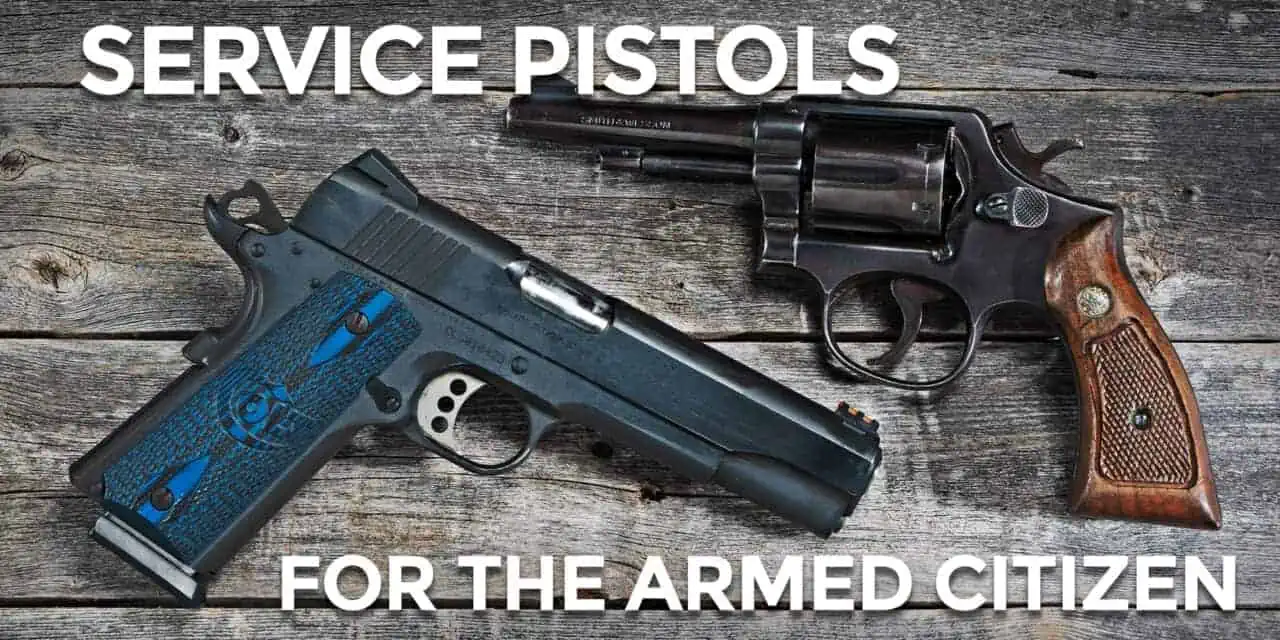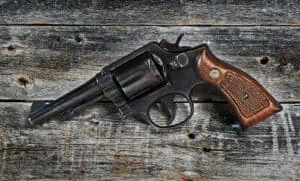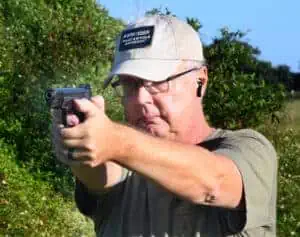A Quick Look At The Service Pistol
Sometime, around 1000 years ago, someone in China figured out that the black powdery substance they were using to make their rockets go up could be placed in a tube. Moreover, if they put stones, pebbles and whatnot into the tube along with the fire powder and torched it off, the people on the front side of the tube would have a very bad day. And thus, the handgun (or handgonne) was created, along with the idea that a compact firearm was a good thing for your average soldier to use in battle.
But it didn’t stop there. The technology of handgonne quickly evolved, and spread among the countries of Europe. Crudely formed cast iron barrels gave way to polished steel. Finely built wooden stocks replaced leaning the gun on a stick for support. Guns fired via bore-poles and powder trails gave way to matchlock actions and the arquebus, which used a trigger attached to slowly-burning pieces of cord to light the gunpowder. It’s at this moment in time where we start to see smaller guns more suitable for close-quarters battle appear on the battlefield. After all, firepower is nice, but firepower and movement? That’s even nicer.
The cavalry units of the early 1500’s decided they wanted to get in on the firearms action along with the infantry. The problem was, the guns of the time had long barrels (three feet long or more) and large, heavy stocks attached to them. Not the sort of thing you’d want to carry around on horseback. The gunsmiths of the day lopped off length from the barrel and the stock, and behold, the handgun was born, perfect for use when your opponent was up-close and personal.
Technology Changed, So Did The Service Pistol
The technology of the handgun kept pace with the rest of the firearms world. Matchlocks gave way to the expensive (but more reliable) wheellock action. The less expensive and just as reliable flintlock action replaced the wheellock. Next, the percussion cap made the entire idea of using a spark from a flint or a match obsolete. Finally, in the mid-1800’s all of the items needed to make a gun go “BANG” and send a bullet downrange where wrapped up in one neat package, the modern, metal-cased ammunition cartridge.
Advancements in the operation of guns coincided with advancements in gun manufacturing. As guns moved to flintlocks to percussion caps to metal cartridges, the creation of the guns themselves moved from individual craftsmen working on one gun at a time to the mass production of individual parts. These individual parts were identical to each other, which meant that one pistol was physically identical to another. This, in turn meant that they could fire standardized ammunition, and behold, the standard-issue service pistol was born.
One of the first orders for a standard-issue service pistol was the Colt Paterson revolver, which was in turn one of the first mass-produced handgun and the first commercially available revolver. This led to a bevy of orders from military units and law enforcement to Colt, Smith and Wesson and other firearms manufacturers for standardized service pistols. Guns like the S&W Model 10 and M&P models, along with the Colt Detective and Colt Trooper became standard issue for law enforcement agencies all over the world.
The Rise Of The Semi-Automatic
Semi-automatic pistols came around in the late 1800’s, and their additional magazine capacity and fast reloads when compared to a revolver made them a very attractive option for the world’s armed forces. The P-08 Parabellum (aka the Luger) was one of the first militaries adopted, initially by the German Navy in 7.65x21mm caliber, (“.30 Luger”) and then later by the German Army in the 9x19mm cartridge we all know and love.
The U.S. military also jumped on the semi-automatic bandwagon and adopted John Moses Browning’s iconic .45 ACP handgun, the gun we now know as the 1911. From 1911 on, the rifles used by our troops changed radically. From the bolt-action 1903 Springfield to the semi-automatic, clip-fed Garand to the lightweight M16 and M4s of the late 20th century. During all that time, however, it was the 1911 that served as the service pistol of the U.S. forces.
Wonder Nines Become The New Standard
Times change, however, and eight rounds of .45ACP lost their luster. The introduction of guns like the Browning HiPower, CZ75, Glock 17, Sig Sauer P226 and others represented a new kind of service pistol. These guns were chambered in 9mm, had double-stack magazines that held twelve or more rounds, and some used advanced polymers for their frames, making them lighter than the equivalent metal-framed gun. These guns, and others like them, became known as ‘wonder nines” for their combination of features and magazine capacity.
The wonder nines quickly gained acceptance around the world, and eventually, the U.S. military retired the 1911 in .45ACP for a variant of the Beretta 92, a metal-framed 9mm that holds 15 rounds of ammo. In 2017, the U.S. Army announced it was replacing their Beretta pistols for two variants of the polymer-framed Sig Sauer P320, the M17 and M18. The new Sig pistols offer the advantages of easily replaceable grip frames that can quickly adapt to different sizes of hands, as well the lighter weight of a polymer frame.
Is A Service Pistol A Good Gun For An Armed Citizen?
Because of their popularity with military and law enforcement, service pistols are well-known and well-loved with America’s armed citizenry. The 1911 is an iconic gun in America, and the Glock 17 and Beretta 92 also have legions of fans. All of these guns have something in common, though. They are meant to be carried on the hip of an on-duty soldier or law enforcement officer. Concealment is not an issue in these cases. However, it is a big issue for armed citizens like you and me, which means they might not be our first choice in a defensive firearm.
With the right combination of holster, belt and cover garment, though, it’s quite possible to conceal a full-sized pistol and carry it all day long. I have many friends who carry a Beretta 92 using appendix carry, and others who carry a Glock 17 on their hips. However, most of my friends who carry prefer smaller, more compact-sized pistols.
A service pistol works great as a home defense gun. The larger size of these guns is not an issue if it stays in the home, and their ability to hold more ammunition is real plus in a defensive encounter. In addition to this, many larger pistols can easily mount an accessory light or laser under the barrel, which are useful accessories in any situation where you have to be 100% sure you are not targeting a friend or family member.
Service Pistols Find A Home In Competition
Full-sized pistols are excellent for competing in practical shooting. IDPA and USPSA have divisions that are tailored to the 1911, and both sports also have divisions for full-size 9mm pistols like the Sig Sauer P226 and CZ75.
The service pistol definitely has a home in the gun safes of America’s armed citizenry. They may be an idea that was built around the needs of the military and law enforcement, but they also have a role to play for those of us who don’t wear a uniform. A reliable, full-sized pistol serves many different purposes, both on the front lines of battle and in your home as well.




